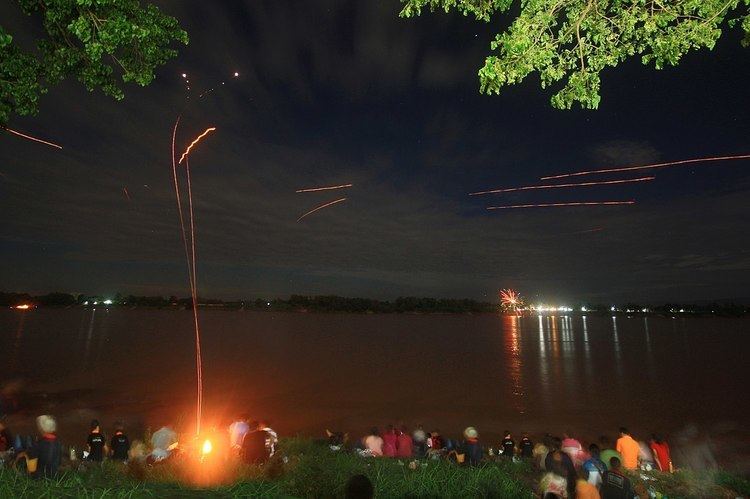 | ||
Naga fireballs (Thai: บั้งไฟพญานาค; rtgs: bang fai phaya nak), also known as bung fai paya nak or Mekong lights, are a phenomenon said to be often seen on the Mekong River. Glowing balls are alleged to naturally rise from the water high into the air. The balls are said to be reddish and to range in size from smaller sparkles up to the size of basketballs. They quickly rise up to a couple of hundred metres before disappearing. The number of fireballs reported varies between tens and thousands per night. The phenomenon is named after the Phaya Naga, legendary serpentine creatures said to live in the Mekong.
Contents
Description
The fireballs are most often reported around the night of Wan Ok Phansa at the end of the Buddhist Lent in late-October.
Naga fireballs have been reported over an approximately 250 kilometre long section of Mekong river with the centre of this section approximately at Phon Phisai town in Amphoe Phon Phisai. Balls have also been reported rising from smaller rivers, lakes and ponds in this region.
Causes and beliefs
Although the fireballs are regularly seen on the river during the Phayanak festival, a 2002 iTV documentary showed Laotian soldiers firing tracer rounds into the air across the river from the festival. Skeptic Brian Dunning suggests that it would be impossible for anyone across the half-mile river to hear a gunshot because it would take 2.5 seconds for the sound to travel to the spectators, and by then the crowd watching would have already noticed the light and started cheering, drowning out the sound when it would reach them. Thai biologist Jessada Denduangboripant analysed footage of a Naga fireball event and concluded that the effect was caused by the firing of flare guns from the other side of the river.
Some individuals have attempted to scientifically explain the phenomenon. One explanation is that the fireball is a result of flammable phosphine gas generated by the marshy environment. Dunning writes that such fireballs are very unlikely to spontaneously ignite, and would not stay lit when traveling at the speeds the fireballs are seen rising at, and that there is no science that can explain "the Naga Fireballs to be naturally produced burning gas bubbles."
A similar explanation involves a similar phenomenon in plasma physics. A free-floating plasma orb, created when surface electricity (e.g., from a capacitor) is discharged into a solution. However, most plasma ball experiments are conducted using high voltage capacitors, microwave oscillators, or microwave ovens, rather than in natural conditions.
